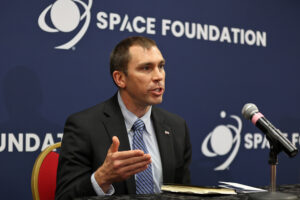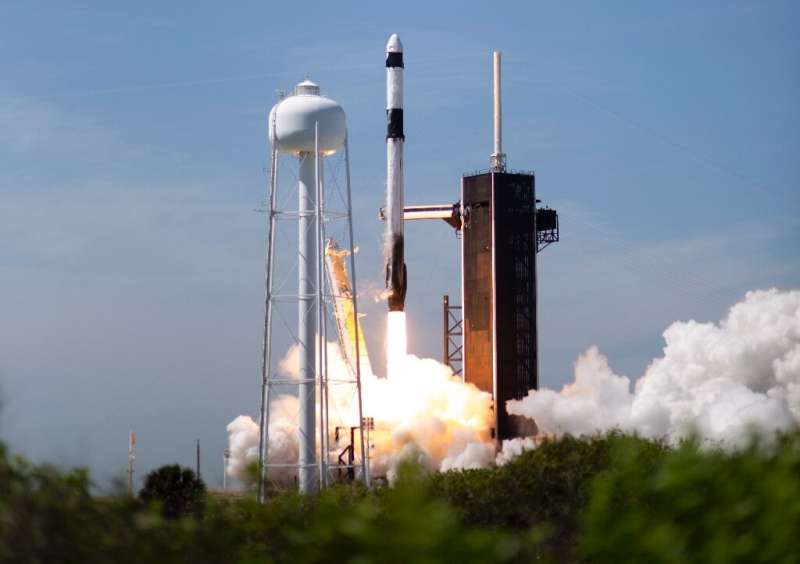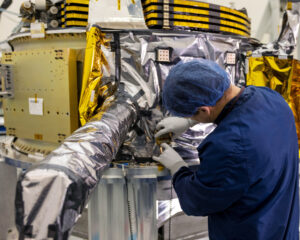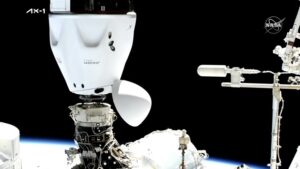CACI completes review for planned 2023 satellite launch
Sunday, 10 April 2022 10:39 CACI International Inc (NYSE: CACI) has completed the Critical Design Review (CDR) for its demonstration small satellite program (DemoSat) launch scheduled for early 2023, which is slated to deliver two mission payloads to low earth orbit. CACI and its partner, York Space Systems - a specialized manufacturer of spacecraft and space collection solutions - will demonstrate alternative positioning,
CACI International Inc (NYSE: CACI) has completed the Critical Design Review (CDR) for its demonstration small satellite program (DemoSat) launch scheduled for early 2023, which is slated to deliver two mission payloads to low earth orbit. CACI and its partner, York Space Systems - a specialized manufacturer of spacecraft and space collection solutions - will demonstrate alternative positioning, The hunt for the gravitational wave background
Sunday, 10 April 2022 10:39 Coalescing supermassive black holes in the centers of merging galaxies fill the universe with low-frequency gravitational waves. Astronomers have been searching for these waves by using large radio telescopes to look for the subtle effect these spacetime ripples have on radio waves emitted by pulsars within our Galaxy.
Now, an international team of scientists has shown that the high-energy
Coalescing supermassive black holes in the centers of merging galaxies fill the universe with low-frequency gravitational waves. Astronomers have been searching for these waves by using large radio telescopes to look for the subtle effect these spacetime ripples have on radio waves emitted by pulsars within our Galaxy.
Now, an international team of scientists has shown that the high-energy Space Development Agency to accelerate deployment of missile-tracking satellites
Sunday, 10 April 2022 10:06
The U.S. Space Force is requesting an additional $200 million in fiscal year 2023 to launch satellites for the Space Development Agency’s missile-tracking constellation.
The post Space Development Agency to accelerate deployment of missile-tracking satellites appeared first on SpaceNews.
First all-private mission docks with ISS
Sunday, 10 April 2022 02:26 The crew from the first all-private mission to the International Space Station docked with the orbital outpost Saturday morning, a historic moment marked by a ceremonial welcome from astronauts on board.
SpaceX's Crew Dragon Endeavor docked at the ISS at 8:29 a.m. EDT and astronauts entered the orbital outpost at 10:13 a.m.
The docking process was held up for about 45 minutes aft
The crew from the first all-private mission to the International Space Station docked with the orbital outpost Saturday morning, a historic moment marked by a ceremonial welcome from astronauts on board.
SpaceX's Crew Dragon Endeavor docked at the ISS at 8:29 a.m. EDT and astronauts entered the orbital outpost at 10:13 a.m.
The docking process was held up for about 45 minutes aft NASA to delay, modify SLS countdown rehearsal
Saturday, 09 April 2022 22:44
After discovering a problem with a valve on the Space Launch System’s upper stage, NASA is delaying a countdown rehearsal and fueling test and modifying it to limit fueling of the upper stage.
First private mission reaches International Space Station
Saturday, 09 April 2022 19:36
The first fully private mission reached the International Space Station early Saturday with a four-member crew from startup company Axiom Space.
NASA has hailed the three-way partnership with Axiom and SpaceX as a key step towards commercializing the region of space known as "Low Earth Orbit," leaving the agency to focus on more ambitious voyages deeper into the cosmos.
A SpaceX Falcon 9 rocket with the Crew Dragon capsule Endeavor docked at 1229 GMT Saturday and the crew entered the space station nearly two hours later, after launching from the Kennedy Space Center in Florida on Friday.
Air Force Research Lab experiment to assess benefits of multi-orbit satellite navigation
Saturday, 09 April 2022 17:41
The Navigation Technology Satellite-3 (NTS-3), an experiment funded by the Air Force Research Laboratory, will broadcast PNT signals from geostationary orbit to supplement GPS satellites in medium Earth orbit
The post Air Force Research Lab experiment to assess benefits of multi-orbit satellite navigation appeared first on SpaceNews.
Air Force space experiment will seek to demonstrate multi-orbit satellite navigation
Saturday, 09 April 2022 17:41
The Navigation Technology Satellite-3 (NTS-3), an experiment funded by the Air Force Research Laboratory, will broadcast PNT signals from geostationary orbit to supplement GPS satellites in medium Earth orbit
The post Air Force space experiment will seek to demonstrate multi-orbit satellite navigation appeared first on SpaceNews.
Japanese satellite laser-comm startup Warpspace draws bead on U.S. market
Saturday, 09 April 2022 15:15
Warpspace, a Japanese space startup developing an inter-satellite laser communications system, is establishing a U.S. presence to partner with American companies and compete for government and military contracts.
The post Japanese satellite laser-comm startup Warpspace draws bead on U.S.
Axiom mission arrives at ISS
Saturday, 09 April 2022 14:49
A SpaceX Crew Dragon spacecraft carrying four private astronauts arrived at the International Space Station April 9 for a scheduled eight-day stay.
The post Axiom mission arrives at ISS appeared first on SpaceNews.
Space tourism: the arguments in favor
Saturday, 09 April 2022 04:04 To its many detractors, space tourism amounts to nothing more than joy-rides for the global super rich that will worsen the planet's climate crisis.
But the nascent sector also has supporters, who, while not rejecting the criticism outright, argue the industry can bring humanity benefits too.
- More research opportunities -
The first argument is that private spaceflights, in additio
To its many detractors, space tourism amounts to nothing more than joy-rides for the global super rich that will worsen the planet's climate crisis.
But the nascent sector also has supporters, who, while not rejecting the criticism outright, argue the industry can bring humanity benefits too.
- More research opportunities -
The first argument is that private spaceflights, in additio SpaceX launches first private astronaut mission to ISS
Saturday, 09 April 2022 04:04 With its 13th launch of the year on Friday, SpaceX will make history, sending the first private crew of astronauts to the International Space Station for a week to conduct dozens of science experiments.
The Ax-1 mission is scheduled to lift off at 11:17 a.m. EDT on a previously flown Falcon 9 rocket that will launch from Pad 39A at NASA's Kennedy Space Center in Florida.
The miss
With its 13th launch of the year on Friday, SpaceX will make history, sending the first private crew of astronauts to the International Space Station for a week to conduct dozens of science experiments.
The Ax-1 mission is scheduled to lift off at 11:17 a.m. EDT on a previously flown Falcon 9 rocket that will launch from Pad 39A at NASA's Kennedy Space Center in Florida.
The miss ISRO likely to launch seven satellites during current year: Govt
Saturday, 09 April 2022 04:04 The Indian Space Research Organisation (ISRO) is likely to launch seven satellites during the current year and the expenditure towards the realisation of satellites is nearly Rs 490 crore, the Parliament was informed on Wednesday.
"ISRO has successfully launched the Earth Observation Satellite EOS-4 onboard PSLV-C52 on February 14, 2022 from Satish Dhawan Space Centre, Sriharikota, along w
The Indian Space Research Organisation (ISRO) is likely to launch seven satellites during the current year and the expenditure towards the realisation of satellites is nearly Rs 490 crore, the Parliament was informed on Wednesday.
"ISRO has successfully launched the Earth Observation Satellite EOS-4 onboard PSLV-C52 on February 14, 2022 from Satish Dhawan Space Centre, Sriharikota, along w Brazilian Space Chief Says Nations Should Think Long-Term, Keep Space Out of Geopolitics
Saturday, 09 April 2022 04:04 Countries should think long-term about space cooperation, as there are many things on which they could work together regardless of geopolitical tensions, Carlos Moura, the president of the Brazilian Space Agency, told Sputnik.
"I believe that, especially in space, we should think long term cooperation, scientific cooperation," Moura said on the sidelines of the Space Symposium. "There are
Countries should think long-term about space cooperation, as there are many things on which they could work together regardless of geopolitical tensions, Carlos Moura, the president of the Brazilian Space Agency, told Sputnik.
"I believe that, especially in space, we should think long term cooperation, scientific cooperation," Moura said on the sidelines of the Space Symposium. "There are A Beacon in the Galaxy: Updated Arecibo Message for Potential FAST and SETI Projects
Saturday, 09 April 2022 04:04 An updated, binary-coded message has been developed for transmission to extraterrestrial intelligences in the Milky Way galaxy. The proposed message includes basic mathematical and physical concepts to establish a universal means of communication followed by information on the biochemical composition of life on Earth, the Solar System's time-stamped position in the Milky Way relative to known gl
An updated, binary-coded message has been developed for transmission to extraterrestrial intelligences in the Milky Way galaxy. The proposed message includes basic mathematical and physical concepts to establish a universal means of communication followed by information on the biochemical composition of life on Earth, the Solar System's time-stamped position in the Milky Way relative to known gl 
